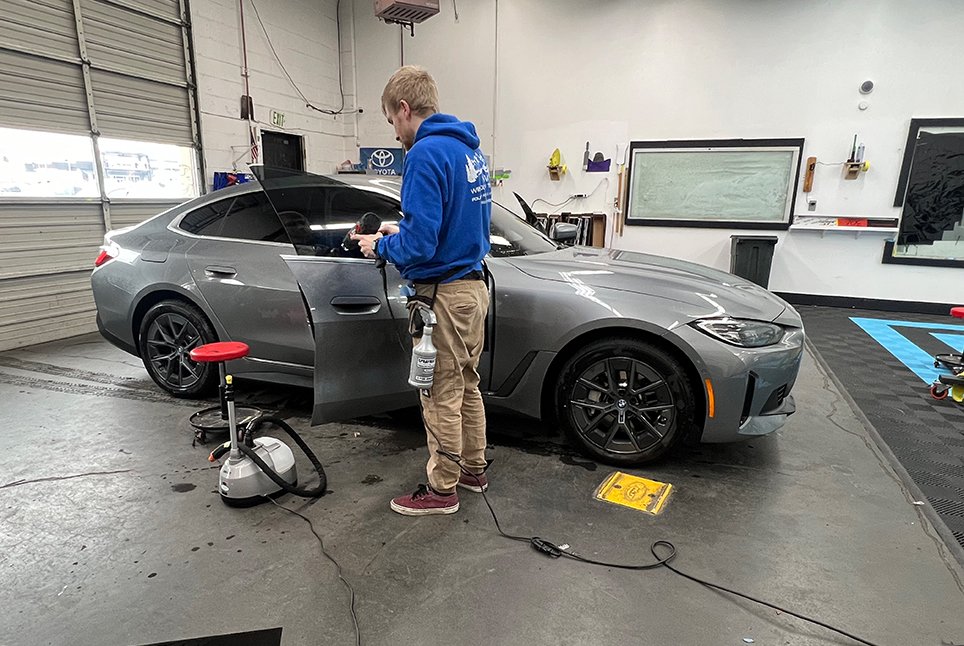Top-Rated Car Window Tinting Solutions in Your Location
Wiki Article
Home Window Tinting Laws and Guidelines: What You Required to Know Prior To Tinting Your Vehicle
Prior to continuing with window tinting for your automobile, it is crucial to acquaint yourself with the varied regulations and standards that control this method throughout various states. These guidelines dictate the allowable levels of tint darkness, commonly measured by visible light transmission (VLT) portions, and consist of details terms for front windshields aimed at making certain road safety.Introduction of Home Window Tinting Laws
Window tinting legislations are regularly subject to variation across various territories, mirroring local policies and security factors to consider. These regulations determine the allowable degrees of color darkness and reflectiveness on lorry windows, guaranteeing that motorists preserve appropriate presence while also safeguarding versus harmful UV rays and heat.Most guidelines classify window tinting based on the Visible Light Transmission (VLT) percent, which indicates the quantity of light that can travel through the home window. Generally, lower VLT percents signify darker colors. Regulations typically differentiate between the front, side, and rear home windows, with more stringent constraints put on the front windshield to enhance safety and security for both the chauffeur and various other roadway individuals.
Conformity with window tinting policies is crucial, as violations can result in penalties, required removal of the color, and potential rises in insurance coverage costs. It is necessary for automobile owners to acquaint themselves with local regulations before continuing with home window tinting setups.
State-by-State Color Regulations
Comprehending the specific window tinting laws in each state is important for lorry owners looking for to comply with the law. Each state in the U.S. has actually established its very own collection of rules controling window tinting, which can vary significantly. These regulations usually determine the permitted degrees of color darkness, the sorts of windows that can be tinted, and any type of clinical exemptions that may use.For example, states like California have rigid limitations on tint darkness for front home windows, while others, such as New Mexico, might permit darker colors. Additionally, specific states mandate details presence percentages for numerous windows, including the windscreen, front side home windows, and back windows. It is critical for cars and truck proprietors to acquaint themselves with their state's regulations to stay clear of possible penalties or fines.
In addition, some states may require an accreditation sticker label to be positioned on colored home windows, showing conformity with state regulations. Failing to abide by these laws not only risks legal repercussions but can also influence safety and visibility while driving. Automobile proprietors need to perform thorough research or seek advice from neighborhood authorities to guarantee complete understanding and conformity with state-by-state tint policies.
Allowed Color Degrees and Kinds
Lots of automobile proprietors might be shocked to discover that permitted color levels and kinds vary widely across various states. Each state has actually developed its very own laws concerning the allowable darkness and reflectivity of window color, commonly determined by Visible Light Transmission (VLT) portions. VLT describes the amount of light that can travel through the tinted home windows; Learn More Here thus, a reduced percent shows a darker tint.
Moreover, the sorts of tint products enabled can vary, with some states banning metallic or mirror-like finishes. It is vital for car proprietors to acquaint themselves with their state's particular regulations to make sure compliance. Non-compliance can result in penalties, necessary removal of the color, or various other legal effects, making it necessary to comprehend these regulations before proceeding with installment.
Medical Exceptions for Tinting
While not all states supply allocations for medical exceptions relating to home window tinting, those that do acknowledge the necessity for certain people to enhance presence and comfort as a result of medical conditions. Numerous medical problems, such as lupus, skin cancer, and specific eye conditions, can make individuals especially conscious sunshine. These people may need darker colors to safeguard themselves from unsafe UV rays and glare.
It is very important to note that despite having a medical exception, there might still be limitations on the degree of tint allowed. Compliance with state legislations ensures that individuals are both safeguarded and within legal limits. Those taking into consideration clinical exemptions ought to call their local Department of Electric motor Automobiles or comparable authority to recognize the requirements and procedures essential to obtain an exemption efficiently.
Charges for Non-Compliance
Falling short to follow window tinting laws can cause substantial fines, which differ by state. Legislation enforcement agencies are equipped to release citations for cars that do not stick to the defined tinting laws. These fines generally include penalties, which can vary from moderate total up to numerous hundred bucks, relying on the extent of the recommended you read violation and the state concerned.In some jurisdictions, repeated offenses may result in intensifying fines or additional penalties, such as obligatory court appearances. Additionally, non-compliance might require the removal of unlawful tinting, typically at the proprietor's cost. In severe situations, regular wrongdoers may deal with suspension of their automobile enrollment up until compliance is achieved.
In addition, insurance coverage ramifications may emerge from obtaining numerous citations for home window tint infractions. Insurance providers may view such violations as an indicator of riskier habits, potentially leading to increased costs or trouble in protection.
To prevent these charges, it is essential for vehicle proprietors to acquaint themselves with their local home window tinting legislations and guarantee click that their vehicle complies (Window Tinting). This aggressive technique not only stays clear of legal ramifications yet likewise advertises road security
Conclusion

The majority of policies identify window tinting based on the Visible Light Transmission (VLT) percent, which indicates the amount of light that can pass via the window. Conformity with window tinting guidelines is essential, as offenses can result in fines, compulsory elimination of the tint, and prospective rises in insurance costs.Recognizing the particular home window tinting regulations in each state is important for automobile owners looking for to comply with the legislation. These laws frequently dictate the allowed levels of color darkness, the kinds of windows that can be tinted, and any clinical exceptions that might use.
For instance, states like California have strict constraints on color darkness for front home windows, while others, such as New Mexico, may allow darker tints.
Report this wiki page